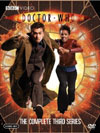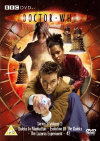DVD Extras (box sets only) include:
Pig men? Of course, it makes sense for the Daleks to want to grab humans and do something to them to make them strong, subservient, obedient slaves. History suggests that turning them into Robomen would be their first choice, which certainly turned out to be a cinematic success in the Peter Cushing feature film Daleks' Invasion Earth 2150 A.D. (theatrical version of story no. 10). Even if the necessary hardware is in short supply, and something far more organic had to be done, there are any number of new mutant forms that could be experimented with until something nasty and believable could be put on the screen. But pig men? By simply picking a common farm animal, for no discernable good reason, it becomes almost laughable and demonstrates a lack of imagination and scope that does not bode well for the future of the show. Mistake no. 2: Showgirls singing on Broadway, getting ready to sing on Broadway, etc., etc. Too Earthy, too limp-wristed, too staged to mix well with action and plot, and most importantly, too far into the musical genre which has always been such a bad combination with science fiction. On another note, the choice of setting itself begs some scrutiny. In other circumstances, 1930's New York, even with Broadway, might be a decent place to set a Doctor Who story, showcasing enough cultural differences from the usual London setting to make a nice diversion as one of, say, the two or three Earth-based stories in a ten-story season. But, look at where they've positioned this story: after two and a half years of barely ever being able to set a story on a planet outside of Earth's orbit, and directly after visiting the not-very-original city of New New York on a copy-cat planet for the second time in the previous story. And after spending too much time on Shakespeare's stage in the story just prior to that. What the production team desperately wants to portray as a cool new expression of dazzling culture and colour on Doctor Who's screen actually comes across as a cheap re-hash of the same old elements they've been chucking at us for some time. Want to impress us? Show us the galaxy, and get back to real alien planets and alien cultures, like the original show had never been afraid to do even on its limited budget. Another big factor to consider here is how much both the writing and the directing of this story seem to be just painting by numbers. The opening shows the usual earthly routine (showgirls) being interrupted by the scare (pig men?!), showcasing both big elemental mistakes. Don't be surprised if it doesn't work for you. But why then, if the Daleks haven't been revealed in the teaser, do Raynor and Co. choose to reveal them in the completely uninspiring title "Daleks in Manhattan"? Daleks themselves always seem to be popular, and so here they are again, doing most of their usual antics and reliving as many scenes from their previous adventures as possible, generally with less inspiration than before. But Daleks have been done so often in the past two years, we aren't really all that excited in seeing them show up yet again, much less occupying one of the double-length slots in the season. Thankfully this painting-by-numbers approach gives us a full materialization of the TARDIS to start the story off right, although Raynor rightly laments about losing the preceding TARDIS interior scene she had written. It's included on the deleted scenes in the box set, and probably wouldn't have demonstrated the interior/exterior relationship to new viewers any better than the scenes in "The Ribos Operation" (story no. 98). Sad. The Doctor and Martha immediately come out to marvel at the culture and landmarks they find surrounding themselves, and quickly identify a mystery worth investigating to occupy themselves while they are there. Sounds good theoretically. But whatever questions fascinate the Doctor remain nebulous and ultimately uninteresting to the audience. Hooverville isn't quite the fresh new scoop of 1930's New York history that the production team think they've unearthed, because we've seen it before on Doctor Who in 1963. It's the petrified forest all over again, full of Thals camping out after their crops have failed and they're forced to search for new means of sustenance. The visual reveal of the Daleks becomes yet another lacklustre going-through-the-motions event. Nick Briggs works hard with the Dalek voice to put extra menace into the Daleks' first few lines, but particularly after the title of the episode, the scene is far too predictable and lacks any anticipation of something surprising or interesting happening. Camera angles also appear uninspired. Having the Dalek flanked by pig men (pig men?!) certainly didn't help. Using the established fish-eye lens for the Dalek's point-of-view only seems to make Mr. Diagoras look silly as he speaks his lines... not a good choice. And if the revelation of the other three Daleks was meant to be something big and unexpected, that totally doesn't come across either. What is interesting is the revelation that this is in fact the "Cult of Skaro" quartet that escaped from a previous story, although that moment isn't memorable enough to notice on subsequent viewing. The Daleks also go through the entire first half of the story without firing a shot to establish the means of their authority, which makes me wonder how any new viewer could understand why they are obeyed and feared. Instead they rely on pig men (pig men?!) for their muscle. Sadly laughable.
The Pointless InvestigationWhat is extremely disappointing is how the Doctor's investigations fall so far behind what the audience already knows, making him rather pointless to the first half of the narrative, his scenes uninteresting. He spends most of the first episode just trying to figure out what the teaser and title have already revealed: that there are Daleks and pig men (pig men?!) behind everything.And he has to do most of that in one of the worst parts of the story's settings. Painting by numbers again, Raynor has dredged up another overused Doctor Who setting in which her monsters can congregate and chase after the protagonists: sewers, which of course for television look more like a bunch of dingey but nicely dry corridors than anything that is actually transporting waste. You could leave out nearly all the sewer scenes and not miss anything worthwhile, and set the chases and other key moments in locations that make for more interesting cinematography.
Things do pick up significantly though, as the Doctor gets a nice moment leading into the most memorable cliffhanger of the season. At last the story reveals some new territory that is worth exploring! Too bad an entire episode was wasted setting it up. Episode Two is definitely on safer ground as it stays out of the sewers and the domain of the showgirls for the most part, recreating some scenes from previous Dalek adventures. The analogy of Thals in Central Park climaxes as Hugh Quarshie's character Solomon takes over the role of Temmosus from 1963's original "The Daleks" (story no. 2). The result is all too predictable. Thankfully, there is a genetic laboratory in this story, in which nearly all of its best scenes and best new elements take place. Dalek Sec proves to be the most interesting character in the piece, both before and after his transformation, the only character allowing viewers to anticipate that they may see something new and fresh occur in a Dalek story. The response from the other Daleks is highly predictable and douses such hopes. The demonic bursts of flame occurring spontaneously in the background of many shots in the lab are of questionable taste and believability, however - style sadly winning out over substance again. As in "Revelation of the Daleks" (story no. 143) and "Bad Wolf" (story no. 170), the Daleks' alienness is sadly diluted as they encroach on the territory of the Cybermen with respect to their view of the human resource. And we practically get a copy-cat scene from "The Evil of the Daleks" (story no. 36) in a smaller and less exciting scale, complete with some identical dialogue. Strategy between the opposing forces is fairly decent throughout most of this second episode. I thought the tale had reached an okay climax at one point, only to be pleasantly surprised as it escalated beyond that and provided even more good stuff. But twice, the Doctor openly begs the Daleks to shoot him, drawing attention to the ridiculousness of the fact that they've labeled him their no. 1 enemy and yet always give him enough rope to thwart their plans while they only gun down the other characters all around him. Too silly. The end generally works, although hindsight reveals that the Daleks had more options at their disposal than they thought of using in the heat of the moment. The Doctor does get his due as main character and central hero, adding a few more notches to his long list of victories.
"And I'm not stupid. I know some guys are just pigs. But not my Laszlo!"As I came to the end of this weird piece, and I found myself wondering why a woman would choose to write showgirls and pigmen (pigmen?!) so prominently in her first blockbuster teleplay (assuming of course that she had a reason other than a man's visual interest in putting showgirls on screen), it began to occur to me that she might by trying to weave a message into the story. Perhaps there was a not-so-hidden message that men shouldn't judge themselves unworthy based on their looks, because women tend to pay more attention to deeper things? But on hearing how tacked-on the actual ending was, and what the alternative was going to be up until almost the last minute, somehow this doesn't seem to be what she had in mind. Showgirls likely just flowed out of Raynor's familiarity with stage production work. Which leaves me wondering all the more how pigmen (pigmen?!) ended up in this tale.
Pigmen?!
International Titles:Deutsch: "Evolution der Daleks"
Magyar: "A dalekok evolúciója"
Français: "DGM : Dalek génétiquement modifié"
Русский: "Эволюция далеков"
Italiano: "L'evoluzione dei Daleks"
Strangely, the Hungarians aren't yet very consistent on how to pluralize the word "Dalek", alternating between "Dalekek" and Dalekok" on titles since 1963. The guiding rule to be used is called "vowel harmony" and it can get a bit subjective. As a relatively new foreign word, who knows how long it will take before the general population feels that one way of saying it is much more natural than the other?
This story has become available on DVD. Click on the Amazon symbol for the location nearest you for pricing and availability:
Note: The full season sets contain commentaries, behind-the-scenes featurettes, and other extras. The smaller volumes only feature the plain episodes. Comments on this article are welcome. You may contact the author from this page:
|










